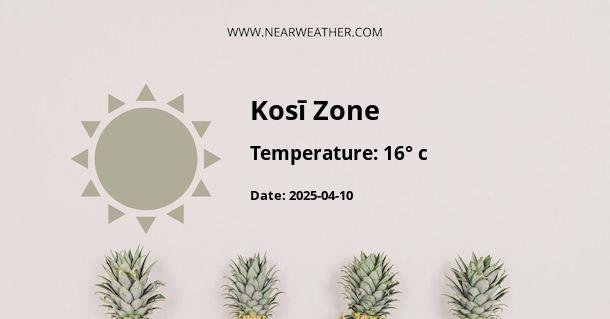Climate and Weather in Kosī Zone, NP
Kosī Zone, located in Province No. 1 of Nepal, experiences a unique and diverse climate throughout the year. Situated in the eastern part of the country, the zone is characterized by its varied topography, which influences the weather patterns in different areas. From the lowlands of the Terai region to the high mountains of the Himalayas, Kosī Zone offers a wide range of climatic conditions.
Temperature and Seasons
The temperature in Kosī Zone varies significantly based on the elevation and season. Generally, the zone has four distinct seasons: spring, summer, autumn, and winter.
Spring (March to May): Spring in Kosī Zone is pleasant with mild temperatures ranging from 15°C to 25°C (59°F to 77°F) in the lowlands. As you move to higher elevations, temperatures gradually decrease. This season brings colorful blossoms, making it an ideal time for nature enthusiasts and trekkers to explore the region.
Summer (June to August): Summers in Kosī Zone are characterized by hot and humid weather, especially in the Terai region. Temperatures can soar up to 35°C (95°F) or higher, while in the hilly areas, temperatures range between 20°C and 30°C (68°F and 86°F). This season also brings monsoon rains, which provide relief from the heat but can cause occasional disruptions.
Autumn (September to November): Autumn is considered the best season to visit Kosī Zone due to its mild temperatures and clear skies. Daytime temperatures range from 15°C to 25°C (59°F to 77°F), offering comfortable weather for outdoor activities and trekking. The region's scenic beauty is enhanced during this time as the hills and mountains are covered with lush greenery.
Winter (December to February): Winters in Kosī Zone are cold, especially in the higher altitudes. The temperatures in the lowlands range from 5°C to 20°C (41°F to 68°F), while in the mountainous regions, temperatures can drop below freezing. This season is ideal for those looking to experience snowfall and engage in winter sports.
Precipitation and Rainfall
Kosī Zone receives the majority of its rainfall during the monsoon season, which lasts from June to September. The Terai region receives higher rainfall compared to the hills and mountains. The average annual rainfall in the Terai is around 1,500 to 2,500 millimeters (59 to 98 inches), while the hilly areas receive approximately 1,000 to 2,000 millimeters (39 to 79 inches) of rainfall.
During the monsoon season, heavy rainfall can cause occasional flooding in the low-lying areas. It is advisable to check weather forecasts and road conditions before traveling during this time.
Topography and Microclimates
Kosī Zone's topography plays a significant role in creating microclimates within the region. The zone encompasses the fertile plains of the Terai, the rolling hills, and the towering peaks of the Himalayas. Each of these areas has its own unique climate and weather patterns.
The Terai region, located in the southern part of the zone, experiences a tropical and humid climate. It is known for its hot summers and mild winters. The hills, located in the middle part of the zone, have a temperate climate with moderate temperatures throughout the year. The mountainous areas, including parts of the Himalayas, have a cold and alpine climate, with temperatures dropping significantly in winter.
Conclusion
Kosī Zone, NP offers a diverse climate and weather experience throughout the year. From the hot and humid summers in the Terai region to the cold winters in the mountains, the zone caters to a wide range of preferences. Whether you seek trekking adventures, natural beauty, or cultural exploration, Kosī Zone has something to offer in every season.
A - Kosī Zone's Latitude is 27.150000 & Longitude is 87.316673.
A - Weather in Kosī Zone is 16° today.
A - Climate Conditions in Kosī Zone shows light rain today.
A - Humidity in Kosī Zone is 77% today.
A - Wind speed in Kosī Zone is 0.43 km/h, flowing at 275° wind direction. today.
